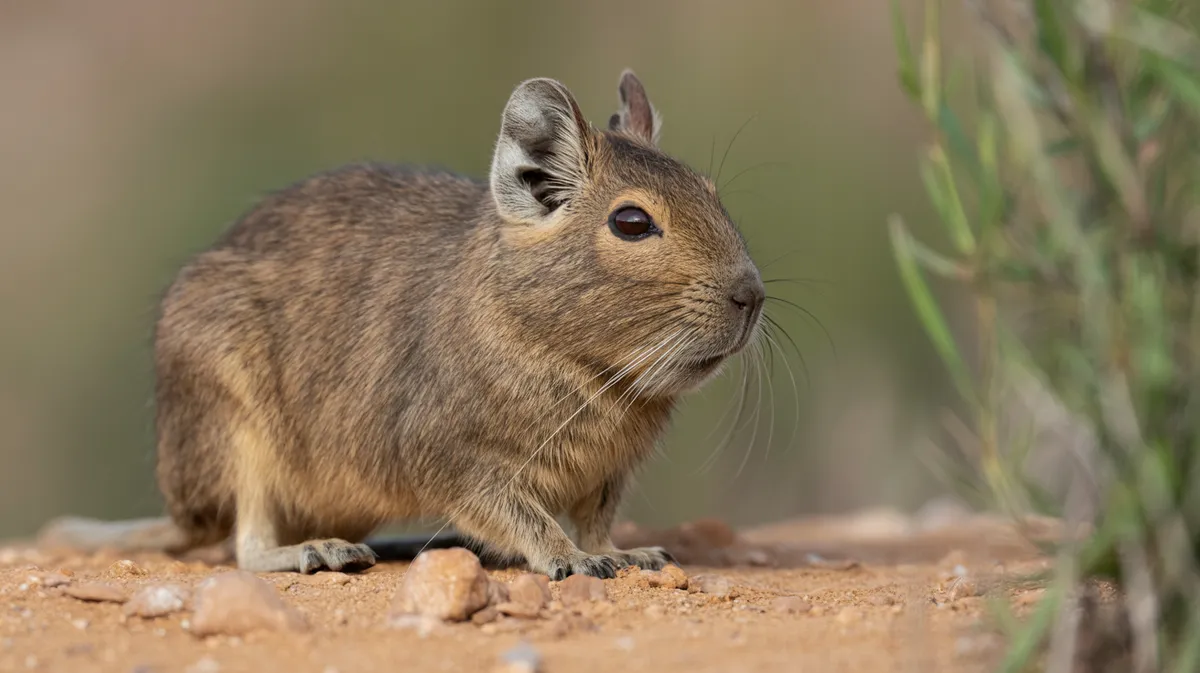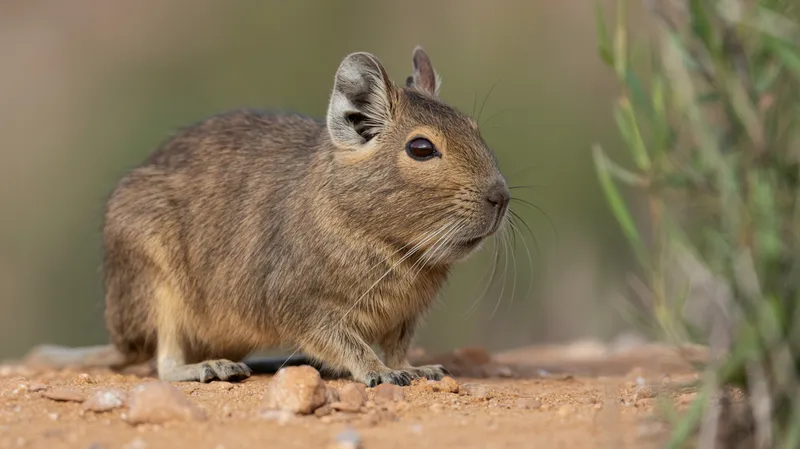
Common Degu
Octodon degus

Meet the Common Degu
The Common Degu is a small, social rodent native to central Chile, known for its diurnal (daytime) activity and complex social structure. Sporting a brownish agouti coat, long tail with a tufted end, and large, expressive eyes, degus are highly active and enjoy burrowing and climbing. These rodents live in large colonies and communicate through a variety of vocalizations and body postures. In the wild, they are most often found in semi-arid scrublands and grasslands, where they construct elaborate burrow systems for shelter and protection. Degus are popular in research and as pets due to their intelligence and engaging behaviors.
Classification
Mammal
Habitat
Semi-arid scrublands and grasslands
Diet
Herbivore
Lifespan
5-8 years in captivity, 1-4 years in the wild
Conservation
Least Concern
Weight
170-300 grams
📖Fascinating Facts
Unique Teeth
Degu teeth are naturally yellow-orange because of a special pigment that helps make them stronger and more resistant to decay.
Daytime Rodent
Unlike most rodents, degus are diurnal, meaning they are primarily active during the day rather than at night.
Complex Communication
Degus use a wide range of vocalizations and body language to communicate within their social groups, including chirps, whistles, and tail wagging.
📋Detailed Description
The Common Degu (Octodon degus) is a medium-sized rodent, typically measuring 23–31 cm in total length, with the tail accounting for about half (10–15 cm). Adults weigh between 170 and 300 grams, with males and females similar in size. Their fur is dense and soft, colored brown agouti dorsally with a paler, creamy ventral side, and their tails end in a distinctive black tuft. Degus possess large, dark eyes adapted for diurnal vision, and their incisors are bright orange due to high iron content, which strengthens them for gnawing tough vegetation. They have five digits on each foot, with strong claws for digging elaborate burrow systems. Social by nature, degus live in colonies of up to 100 individuals, exhibiting complex social hierarchies and cooperative behaviors. Communication is multifaceted, involving over 15 distinct vocalizations, scent-marking, and tactile interactions. Their cognitive abilities are notable among rodents, including spatial memory and problem-solving skills. In the wild, degus are primarily herbivorous, feeding on a variety of grasses, seeds, leaves, and bark, and they have specialized digestive adaptations for processing fibrous, low-nutrient diets.
💡 Did you know?
Degus are one of the few non-primate animals known to demonstrate a sense of object permanence and can even use tools in experimental settings.
🔬Research & Sources
Wikipedia Summary
The common degu, or, historically, the degu, is a small hystricomorpha rodent endemic to the Chilean matorral ecoregion of central Chile. The name degu on its own indicates either the entire genus Octodon or, more commonly, just the common degu. Common degus belong to the parvorder Caviomorpha of the infraorder Hystricognathi, along with the chinchilla and guinea pig. The word degu comes from the indigenous language of Chile, Mapudungun, and the word dewü, meaning 'mouse' or 'rat'.
Last Modified: 6/9/2025
🎭Behavior & Social Structure
Common degus are strictly diurnal, with peak activity during early morning and late afternoon, likely as an adaptation to avoid midday heat and predators. They are highly social, engaging in communal grooming, cooperative rearing of young, and coordinated foraging. Degus establish and defend territories marked by urine and glandular secretions. Their vocal repertoire includes alarm calls, contact calls, and mating calls, each with specific acoustic structures. Feeding is opportunistic but selective; degus often cache food in underground chambers for periods of scarcity. They are adept diggers, constructing multi-entrance burrow systems that provide shelter, food storage, and nesting sites. Play behavior is common, especially among juveniles, and includes chasing, wrestling, and object manipulation. Aggression is rare but can occur during territorial disputes or breeding competition.
👶Reproduction & Life Cycle
Degus are seasonally polyestrous, with breeding typically occurring in the austral spring and summer (September to March). Females exhibit postpartum estrus, allowing for rapid successive litters. Gestation lasts approximately 90 days, unusually long for a rodent of their size, resulting in highly precocial young born fully furred, with open eyes and erupted teeth. Litter sizes range from 4 to 10 pups, with an average of 5–6. Both males and females participate in parental care, including nest building, grooming, and protection. Communal nursing is common, with multiple females caring for and feeding each other's young. Weaning occurs at around 4–5 weeks, and sexual maturity is reached at 3–6 months. High reproductive output and cooperative breeding contribute to their ecological success.
🛡️Adaptations & Survival
Degus exhibit several adaptations for survival in semi-arid environments. Their kidneys are highly efficient at conserving water, producing concentrated urine to minimize loss. They possess a cecum specialized for hindgut fermentation, allowing extraction of nutrients from fibrous plant material. Degus are intolerant of dietary sugars, a trait linked to their natural low-sugar diet; in captivity, high-sugar foods can induce diabetes mellitus. Their incisors contain iron-rich pigments, enhancing durability for gnawing tough vegetation and bark. Social living provides protection from predators and environmental extremes, while communal burrowing reduces individual energy expenditure. Their keen vision, including some sensitivity to ultraviolet light, aids in detecting predators and social cues.
📚Research Sources
🎨Cultural Significance
In Chile, degus have limited direct cultural significance but are recognized in indigenous Mapuche language and folklore, where their industriousness and social nature are sometimes referenced. They have gained international prominence as research models in neuroscience, diabetes, and social behavior studies, due to their unique physiology and cognitive abilities. In the pet trade, degus are valued for their intelligence, trainability, and engaging personalities, though their specialized dietary needs limit their popularity compared to other rodents.
🔬Recent Research & Discoveries
Recent research has highlighted the degu as a valuable model for studying social cognition, Alzheimer's disease, and diabetes mellitus. Their natural tendency to develop age-related neuropathologies, including amyloid plaque formation, parallels aspects of human neurodegenerative diseases. Studies on degu vocal communication have revealed complex syntax and context-dependent signaling, advancing understanding of rodent sociality. Ongoing ecological research focuses on their role as ecosystem engineers, influencing soil turnover and plant community dynamics through burrowing and selective feeding. Genetic studies are elucidating their evolutionary relationships within Caviomorpha, contributing to broader knowledge of South American rodent diversification.
🎥Wildlife Videos

Degu | Reportage für Kinder | Anna und die Haustiere
Tierisch interessant: Noch mehr spannende Videos findest Du in der Wilden Tierwelt der ARD-Mediathek: ...
Wilde Tierwelt

Exotic animals in their natural habitat
via YouTube Capture.
Pumpkin ghost 810

Degus | The ARC Centre
This week our cheeky little degu Ninja is the star of the videos! Thank you so much to everyone who has been able to support The ...
The ARC Centre

RODENTS
Well-known rodents include mice, rats, squirrels, prairie dogs, porcupines, beavers, guinea pigs, hamsters, gerbils and capybaras.
john pearce
![The cuttest flying Rodent ] Northern sauirellel ] Rapid animal.](https://i.ytimg.com/vi/3hscVJVscOk/mqdefault.jpg)
The cuttest flying Rodent ] Northern sauirellel ] Rapid animal.
The Flying northern squrellel, Northern surellel, southern squrellel, Rapid animal, the cutest flying rodent,rodent,flying squirrel ...
wildlife animals of sindh

Teporingo | Documentaire Animalier
Teporingo | Documentaire Animalier Le Teporingo est l'un des animaux les plus emblématiques et menacés du Mexique, et ce ...
Cityanimal FR
🌍Habitat Information
The Common Degu typically inhabits Semi-arid scrublands and grasslands environments. Common Degus have adapted to their environments with specialized features and behaviors.
Primary Habitat:
Semi-arid scrublands and grasslands
More detailed habitat information will be available soon.
🛡️Conservation Status
The Common Degu is currently classified as Least Concern. Conservation efforts are crucial for preserving this species for future generations.
Common Threats:
- 🏠Habitat loss and fragmentation
- 🌡️Climate change impacts
- 🎯Hunting and poaching
- 🏭Human-wildlife conflict
⚠️Threats & Conservation Challenges
Currently classified as Least Concern by the IUCN, the Common Degu faces localized threats from habitat loss due to agricultural expansion, urbanization, and invasive plant species altering native vegetation. Predation by introduced species such as domestic cats and dogs poses additional risks. In some regions, degus are considered agricultural pests and subject to control measures. Climate change, particularly increasing aridity and temperature extremes, may impact food availability and burrow microclimates. Despite these challenges, degus remain widespread and adaptable, with stable population trends in most areas.
🔬Scientific Classification
Scientific Name
Octodon degus
Classification Hierarchy
🔍 About Taxonomic Classification
Taxonomic classification is a hierarchical system used by scientists to classify and organize living organisms based on shared characteristics and evolutionary relationships.
The system moves from broad categories (Kingdom) to increasingly specific ones, with each animal's scientific name typically consisting of its Genus and species.
📝Community Notes
Share your observations and insights about the Common Degu with our community of wildlife enthusiasts.
Join Our Community
Sign in to share your observations and connect with fellow wildlife enthusiasts.
Sign In to ContributeNo community notes yet
Be the first to share your observations about the Common Degu!
Explore Common Degu
Select a tab above to learn more about this amazing animal.
📸Photo Gallery
No photos available for this animal yet.
🌟Discover More Wildlife
Continue your journey of discovery with more fascinating animals from our database
